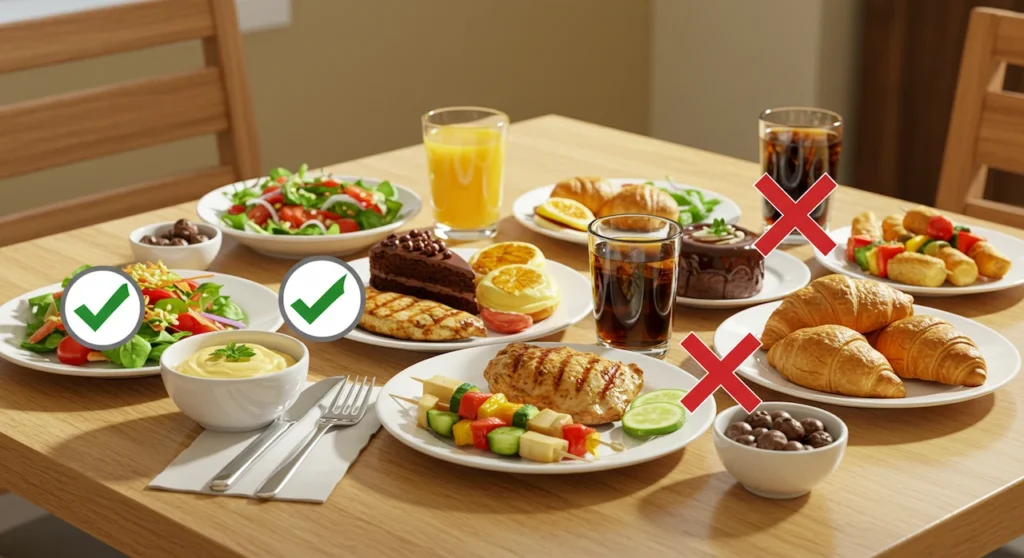Anúncio
You check your blood sugar religiously. Always count carbs and take your medication exactly as prescribed. But your numbers keep spiking anyway, and you can’t figure out why.
Anúncio
Here’s the brutal truth: some of the foods sitting in your kitchen right now—foods you’ve been told are “healthy” or “diabetic-friendly”—are quietly wreaking havoc on your glucose levels.

White Rice: The Blood Sugar Rocket Fuel
White rice might be a staple in many cuisines around the globe, but when it comes to managing blood sugar, it’s one of the biggest offenders hiding in plain sight. Stripped of its outer husk, bran, and germ, white rice is essentially a refined carbohydrate that the body digests with startling speed. This process floods your bloodstream with glucose, leading to sharp, immediate spikes in blood sugar levels. What’s more, the glycemic index (GI) of white rice is alarmingly high—often in the 70s or 80s—meaning it behaves more like sugar than a slow-digesting grain.
Anúncio
Consider this: a cup of cooked white rice can cause a comparable insulin response to a can of soda. This doesn’t just affect diabetics—frequent blood sugar spikes in non-diabetics can lead to insulin resistance over time, a precursor to type 2 diabetes. Even “healthier-looking” options like jasmine or basmati rice offer minimal advantages unless you’re specifically choosing the brown or wild versions.
What’s the alternative? Swap white rice for whole grains such as quinoa, barley, or bulgur. Not only do they have more fiber, but they also digest more slowly, helping your blood sugar remain stable. Adding a protein or healthy fat alongside your grain can also buffer glucose absorption, giving your pancreas a break.
Fruit Juice: Liquid Sugar in Disguise
Drinking a glass of orange juice first thing in the morning may feel like a healthy habit. However, the reality is far less sweet. Fruit juice, even when labeled “100% natural,” is essentially fruit with all the fiber removed—and fiber is the critical component that slows down sugar absorption.
Let’s do the math: a single 12-ounce glass of orange juice contains about 30 grams of sugar—equivalent to seven teaspoons. That’s more than what you’d find in many candy bars. Without fiber to delay digestion, this sugar is rapidly absorbed, causing your blood glucose to skyrocket. Plus, because it’s in liquid form, it passes through your stomach even faster than solid food, compounding the problem.
Even juices marketed as “no sugar added” or “cold-pressed” can wreak havoc if you’re trying to control glucose levels. Instead of fruit juice, opt for whole fruits like oranges or apples. The fiber in the fruit’s flesh and peel not only supports healthy digestion but also keeps glucose spikes in check. You can also enhance hydration with infused water—just add slices of lemon, cucumber, or berries for a refreshing, blood-sugar-friendly drink.
Whole Wheat Bread: The Healthy Food Lie
“Whole wheat” sounds like the gold standard of healthy eating, doesn’t it? But don’t be fooled by the label alone. Many commercial whole wheat breads are made from flour that has been finely milled, removing much of the grain’s natural structure. As a result, your body digests them almost as quickly as white bread.
What’s more troubling is the illusion of health that surrounds these products. Shoppers often trust “whole grain” labels without reading the ingredient list. Some of these breads contain high-fructose corn syrup or molasses—sweeteners that exacerbate the problem. Their impact on your blood sugar? Surprisingly sharp and sustained.
If you want a bread that genuinely supports glucose control, choose one made from sprouted grains. These maintain the integrity of the whole kernel and release glucose much more gradually. Look for products where “whole grain” is the first ingredient and that contain visible seeds, grains, or nuts. Also, keep an eye out for added sugars—even one or two grams per slice can accumulate quickly over the course of a day.
Dried Fruits: Nature’s Candy Trap
At first glance, dried fruits appear to be a convenient and nutritious snack. They’re portable, shelf-stable, and often marketed as a wholesome alternative to candy. But don’t let the packaging fool you. The dehydration process concentrates sugar to intense levels, removing water but leaving behind all the natural fructose—and then some. Often, food manufacturers add extra sugar or syrup to boost flavor and extend shelf life.
To put things into perspective, one cup of fresh grapes contains about 15 grams of sugar. The same volume of raisins? Over 85 grams. That’s more than five times the sugar in a smaller volume—without any fiber or water to slow digestion.
Moreover, many people don’t realize how easy it is to overeat dried fruit. A handful of dried cranberries or dates may seem harmless, but it can deliver a massive sugar payload. Instead, opt for small servings of fresh fruits and pair them with nuts or cheese to blunt the glycemic load. If you must have dried fruit, choose unsweetened versions and keep your portions to a tablespoon or two.
Flavored Yogurt: The Breakfast Betrayal
Flavored yogurts have become a go-to choice for busy mornings. They’re convenient, tasty, and often fortified with “gut-friendly” probiotics. Unfortunately, most flavored yogurts—especially low-fat or non-fat varieties—are loaded with added sugars, often more than what you’d find in a serving of dessert.
In fact, some fruit-flavored yogurts contain up to 20 grams of sugar per 6-ounce serving. That’s equivalent to five teaspoons. Why so much? When the fat is removed, manufacturers often compensate with sugar or artificial sweeteners to maintain taste and texture. These additions sabotage the very health benefits the product claims to offer.
The good news is you don’t need to give up yogurt altogether. Choose plain, unsweetened Greek yogurt. Its higher protein content helps stabilize blood sugar, and its natural tartness pairs beautifully with berries, cinnamon, or a drizzle of raw honey (used sparingly). Adding chia seeds or flaxseeds also increases fiber and omega-3s, turning breakfast into a blood-sugar-friendly powerhouse.
Sports Drinks: The Hydration Hoax
Sports drinks might look appealing after a workout, with promises of hydration and electrolyte replenishment. But unless you’re an athlete engaging in high-intensity training or endurance sports, these beverages are overkill—and a risky choice for your glucose levels.
A typical sports drink contains 20 to 30 grams of sugar per bottle, and many also include artificial flavors, dyes, and preservatives. Originally formulated for elite athletes burning thousands of calories, these drinks have since been rebranded for mainstream consumption. The result? A hydration product that delivers more sugar than benefit to the average person.
Water remains the best way to stay hydrated. If you’ve been sweating heavily or need to replenish electrolytes, consider natural options like coconut water (in moderation) or a homemade mix with water, lemon juice, and a pinch of salt. Always read labels, and be cautious with “zero-calorie” versions—they often contain artificial sweeteners that may still impact insulin sensitivity in some individuals.
Instant Oatmeal: The Fiber Fantasy
Oats are generally hailed as a health food, and they deserve that reputation—when they’re minimally processed. But instant oatmeal is a different story. These quick-cooking versions are rolled thinner, pre-cooked, and sometimes chopped into tiny pieces. This means they hit your bloodstream much faster than their steel-cut or old-fashioned counterparts.
Even worse, instant oatmeal often comes in flavored packets loaded with sugar, salt, and artificial additives. A “maple and brown sugar” variety can have more than 12 grams of added sugar per serving. Combine that with a high GI from overprocessing, and you’ve got a breakfast that can spike your glucose before your day even begins.
Instead, choose steel-cut or rolled oats, and cook them yourself. This small act of preparation gives you full control over what goes into your bowl. Enhance flavor naturally with cinnamon, unsweetened cocoa, or nut butter. You can even batch cook oats ahead of time and refrigerate them for the week.
Restaurant Salads: The Hidden Sugar Bombs
Salads are often viewed as the epitome of healthy eating. However, dining out turns that assumption on its head. Many restaurant salads are packed with hidden sugars, especially in their dressings. Sweet vinaigrettes, honey mustard, balsamic glazes—all of these can add 10–20 grams of sugar per serving, and that’s before we factor in toppings.
Candied nuts, dried cranberries, croutons, tortilla strips, and barbecue chicken all contribute to the sugar and carbohydrate overload. Ironically, a “grilled chicken salad” with the wrong dressing and toppings can rival or exceed the carb content of a cheeseburger and fries.
To regain control, ask for your dressing on the side and choose oil and vinegar when possible. Skip sugar-coated nuts and dried fruits. Opt for lean proteins like grilled salmon or chicken and load up on non-starchy vegetables like leafy greens, cucumbers, peppers, and radishes. In doing so, you not only keep blood sugar in check but also get the true health benefits a salad can offer.
Conclusion
It’s unsettling to realize how many common foods—especially those we trust as “healthy”—can quietly derail blood sugar management. Yet, this awareness is empowering. By recognizing and understanding these hidden saboteurs, you can reclaim control over your health and make choices that genuinely support your metabolic well-being.
The key takeaway? You don’t need to fear food, but you do need to be informed. With just a few thoughtful swaps and a closer look at nutrition labels, you can drastically reduce the daily glucose rollercoaster. And while everyone’s needs are different, one thing remains constant: knowledge is your most reliable ally.
Of course, this information is meant to support your well-being—not replace professional medical advice. Always consult a qualified healthcare provider when making changes to your health regimen.
